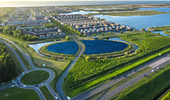Insurers are seriously concerned about climate damage caused by rising sea levels, an increase in drought and more extreme rainfall. This leads to more flooding or long periods of drought. Both weather extremes lead to private and business damage to homes, business premises and cars. But also damage to crops, damage due to business interruption and damage to government property, which as a rule is not insured.
On this page, we explain our positions and actions to prevent damage caused by flooding and drought and what insurers do if damage does occur now or in the future.
Flooding: what is insured?
In the advisory report Floods (2018), the Association advises its members to also provide cover for local flooding in the building and contents policy. It differs per insurer whether - and how - they have translated this advice into their own terms and conditions.
The Association, in collaboration with the Ministry of Infrastructure and Water Management, has produced a number of general infographics showing how weather damage is generally insured, including rain and flooding. Always look at your policy conditions to see exactly what is covered and whether you have a deductible.
Damage caused by direct precipitation, overflowing streams and secondary flood defences
Almost all insurers cover the damage to homes and streams overflowing due to the extreme rainfall and, more recently, the collapse of secondary flood defences ('local flooding'). Damage caused by, for example, the failure of facilities, such as electricity, is also generally covered by the policy conditions.
In the case of business damage, the situation is somewhat different. The above causes of damage are now also insured on most business policies, but insurance for entrepreneurs is often tailor-made, with the help of a financial adviser. Some companies and institutions have insured themselves through a so-called 'stock exchange policy'. With the additional model clause of the VNAB , the stock exchange policy can easily be extended to include flooding of so-called secondary flood defences: small rivers and streams, the local flood risk. With this, insurers and advisers are taking another important step in further insuring flood risks in the Netherlands. We advise entrepreneurs to contact their own adviser/insurance broker. The trade association Adfiz has set up a knowledge portal for financial advisers.
Great rivers and the sea
The situation is different in the case of flooding of major rivers, such as the Meuse, large inland waterways, such as the IJsselmeer, or from the sea. Fortunately, we have very good in our country. But if things go wrong, the damage can be so great that insurers cannot bear the risk. In addition, there is insufficient demand for insurance for larger rivers and the sea. This is due to low risk awareness among people, and because not everyone is at the same risk of flooding. But also because of the existence of the 'free' government compensation through the Disaster Damage Compensation Act (Wts).
It is estimated that 99% of households and businesses are not insured against flooding from the sea and major rivers. While insurance policies actually contribute to a faster recovery and less consequential damage. The Association is now discussing this with the government and other relevant organisations.
Research by the Association into possibilities
There are many examples abroad, mostly public-private partnerships. In recent months, the Association has investigated nine options, of which roughly three directions remained that seem suitable for the Dutch situation. The basis is the scenario in which the insurers take on a leading role in the implementation of the government compensation (Wts), provided that clear conditions and workable protocols apply. A step further are flood insurance, in which insurers jointly bear part of the financial risk, and the government and possibly international reinsurers step in for the major risks.
In all scenarios, the current Disaster Damage Compensation Act (Wts) must be amended so that it becomes more clearly explainable and feasible. We call this Wts 2.0. The Alliance presented these options to various ministries in mid-2023, which will make their own considerations in the coming months."
Measures after water damage
After flooding, the water must be pumped out and the mess cleaned up. There is a lot to consider when it comes to tidying up, cleaning and drying after water damage. We would like to warn you of the following dangerous situations:
Protection – Do not simply walk through the water if the electricity has not yet been turned off or the water is potentially heavily contaminated. Make sure the skin is covered.
Drying Process – The drying process is a lengthy process. Forced and accelerated drying can lead to more damage to the home than a gradual and natural drying process.
Drying time – Remove wet carpets and carpeting, this will help the drying time of the property and its contents.
Ventilation – Open windows and doors so that the room is ventilated as much as possible.
Back pressure - When pumping out rooms such as basements, basements and living rooms, take into account back pressure of water in adjacent rooms. Allow the water to drop evenly to avoid uneven pressure on walls.
Meter cupboard - Is or was there water in the meter cupboard? Then have it checked by an electrician first.
Electricity – Water and electricity is a dangerous combination. Therefore, do not test electrical equipment to see whether it is working or not. Have this assessed by a specialist. This will prevent the risk of short circuits and fires.
Vehicles - Do you have a vehicle that has been in the water for an extended period of time? Then don't start it right away.
Also read the leaflet 'First aid for individuals' from Stichting Salvage. Here you will find information about how Salvage helps victims and what you can do yourself after damage.
Flood Limburg
Damage Limburg 211 million euros
The total insured damage due to the severe weather in Limburg and North Brabantin the summer of 2021 amounted to 211 million euros, the majority of which was in South Limburg, according to the insurance sector's annual financial report.
In total, insurers received approximately 25,000 claims in 2021 as a result of the flooding in July, the majority of which (10,000 claims) were in South Limburg. The majority of claims concern private damage to homes and vehicles. A smaller part concerns business damage to company buildings and vehicles. In addition to material damage, there is also damage to crops and due to business interruption. Finally, there is a lot of damage to government property, which is generally not insured.
Complexity of water damage
Insurers did everything in their power to settle the insured claims quickly, but ran into complex water damage that took months to dry. Very annoying for victims who would like to return home as soon as possible or make a restart with their business. In some cases, this takes a lot of time.
How did the claims settlement get underway?
In Limburg, from 15 July onwards, emergency services came and went. The municipality, the fire brigade, the Ministry of Defence and local residents came to the rescue. Insurers also took action through the deployment of Salvage coordinators, claims handlers, loss adjusters and cleaning specialists. How did the claims settlement process get underway and how do these professionals work together to assist clients in need? The Association discussed this with Stichting Salvage, a.s.r. and Polygon Nederland.
Read the entire article 'Flooding in Limburg: this is how the settlement of claims got underway'
Drought damage
Foundation damage
The low groundwater level, partly due to climate change, threatens the foundations of approximately 1 million homes and other buildings in large parts of the Netherlands. This causes damage to wooden and shallow foundations.
> Visit our page on foundation damage
Subsidence
As far as subsidence is concerned, the risk is so certain and great that insurance is not a solution: it is a billion-dollar risk for homeowners and their mortgage lenders. In addition to climate change, groundwater level management and foundation types also play a role. That is why national direction is needed, and insurers are advocating this together with a broad coalition.
Wildfires
Due to climate change, wildfires will not only occur more often in our country, but will also have a greater impact. It is getting warmer and drier in the Netherlands. This is evident from various Climate Scenarios of the Royal Netherlands Meteorological Institute (KNMI). The weather is becoming more extreme in a general sense. The consequences of this can be seen in our Climate Damage Monitor, in which we keep track of the insured damage caused by extreme weather. We now also know that the risk of wildfires is increasing. Keeping these kinds of risks manageable must be done in collaboration between insurers, government and science.
Catelijne Stoof, internationally known for her expertise on wildfires, previously emphasised during a webinar of the Association that an integrated approach is needed. We support the recommendation to include wildfire risk in decisions about the design of the Netherlands.





